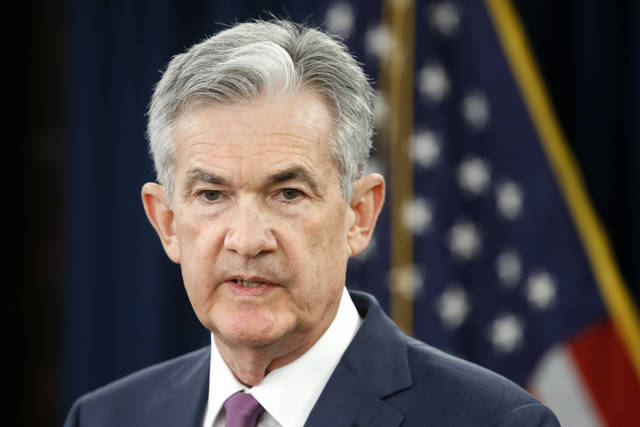WASHINGTON — The Federal Reserve said Friday it expects low unemployment and rising inflation will keep it on track to raise interest rates at a gradual pace over the next two years. By late 2019, the Fed says its key policy rate should be at a level that will be slightly restrictive for growth.
The Fed’s projection on rate hikes came with release of the central bank’s semi-annual monetary report to Congress. Fed Chairman Jerome Powell is scheduled to testify on the report for two days next week.
The Fed last month raised its policy rate for a second time this year and projected two more hikes in 2018. The monetary report says the expectation is that further hikes will leave the rate slightly above its neutral level by late next year.
The Fed’s current projection for the neutral rate — the point where monetary policy is not stimulating growth or restraining it — is 2.9 percent. With the June rate hike, the current range for the policy rate, known as the federal funds rate, is 1.75 percent to 2 percent.
The policy report says that officials’ median outlook for the future course of interest rates would put the policy rate “somewhat above” the neutral rate by the end of 2019 and through 2020.
The report noted that the median projection for the funds rate has it rising to 2.4 percent by the end of this year, which would indicate two more rate hikes are upcoming in 2018, and then climbing to 3.1 percent by the end of 2019 and 3.4 percent by the end of 2020.
That forecast would mean that the Fed’s interest rates would cross a major milestone next year toward a point where Fed interest rates are no longer being kept low to boost economic growth and will instead begin to slightly restrain growth in an effort to make sure that low unemployment does not cause the economy to overheat and trigger rising inflation.
The Fed’s interest rate has not been restrictive for over a decade. In response to the 2008 financial crisis, the Fed cut its policy rate to a record low near zero in December 2008 and kept it there for seven years. It boosted rates by a modest quarter-point in both 2015 and 2016 and then raised rates by three times last year as the economic recovery finally began to gain momentum.
Powell, who will testify next Tuesday before the Senate Banking Committee and on Wednesday to the House Financial Services Committee, said in an interview this week that he believed “the economy’s in a really good place” at the moment with unemployment at the lowest point in nearly two decades and inflation finally approaching the Fed’s optimal goal of 2 percent annual increases.
In the monetary policy report, the Fed said that it expects “a gradual approach to increasing the target range for the federal funds rate will be consistent with a sustained expansion of economic activity, strong labor market conditions and inflation near the committee’s symmetric 2 percent objective over the medium term.”
The monetary report noted that worries about rising trade tensions had caused a period of turbulence in financial markets earlier this year.
In his interview with the radio program “Marketplace” on Thursday, Powell said that Fed officials have been hearing a “rising level of concern” from business executives following the tough talk from the Trump administration, which has imposed penalty tariffs on a number of countries in an effort to open markets for U.S. goods. The effort has provoked retaliation, and now the world’s two biggest economies, the United States and China, are in a full-blown trade war.
In the interview, Powell said he was “very pleased with the results” of the Fed’s gradual pace of rate hikes.
“We’re returning rates to a more normal level,” Powell said. “If we leave rates too low for too long, then we can have too high inflation or we can have asset bubbles or housing bubbles. If we move too quickly, then we can unintentionally put the economy into a recession.”
Powell was tapped by President Donald Trump to succeed Janet Yellen in February as Fed chairman after Trump decided not to offer Yellen a second term. Trump during the campaign was highly critical of the Federal Reserve, accusing officials of keeping rates at ultra-low levels to favor Democrats.
While Trump has not attacked the Fed since becoming president, Larry Kudlow, his chief economic adviser, said in a recent interview that he hopes the Fed would raise interest rates “very slowly,” comments that were seen as breaking more than two decades of precedent where the White House has refrained from commenting on Fed policies.
But Powell said he was not concerned that the Trump administration might try to exert pressure to influence the Fed’s actions on interest rates.
“We have a long tradition here of conducting policy in a particular way and that way is independent of all political concerns,” Powell said.


